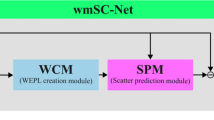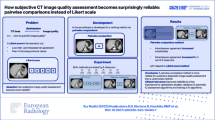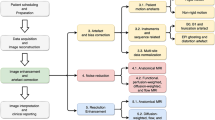Abstract
In fluoroscopy-guided interventions (FGIs), obtaining large quantities of labelled data for deep learning (DL) can be difficult. Synthetic labelled data can serve as an alternative, generated via pseudo 2D projections of CT volumetric data. However, contrasted vessels have low visibility in simple 2D projections of contrasted CT data. To overcome this, we propose an alternative method to generate fluoroscopy-like radiographs from contrasted head CT Angiography (CTA) volumetric data. The technique involves segmentation of brain tissue, bone, and contrasted vessels from CTA volumetric data, followed by an algorithm to adjust HU values, and finally, a standard ray-based projection is applied to generate the 2D image. The resulting synthetic images were compared to clinical fluoroscopy images for perceptual similarity and subject contrast measurements. Good perceptual similarity was demonstrated on vessel-enhanced synthetic images as compared to the clinical fluoroscopic images. Statistical tests of equivalence show that enhanced synthetic and clinical images have statistically equivalent mean subject contrast within 25% bounds. Furthermore, validation experiments confirmed that the proposed method for generating synthetic images improved the performance of DL models in certain regression tasks, such as localizing anatomical landmarks in clinical fluoroscopy images. Through enhanced pseudo 2D projection of CTA volume data, synthetic images with similar features to real clinical fluoroscopic images can be generated. The use of synthetic images as an alternative source for DL datasets represents a potential solution to the application of DL in FGIs procedures.








Similar content being viewed by others
Data availability
The study data are not available for public release.
References
Cui S, Tseng H, Pakela J et al (2020) Introduction to machine and deep learning for medical physicists. Med Phys. https://doi.org/10.1002/mp.14140
Kim M, Yun J, Cho Y et al (2019) Deep learning in medical imaging. Neurospine 16:657–668. https://doi.org/10.14245/ns.1938396.198
Shen C, Nguyen D, Zhou Z et al (2020) An introduction to deep learning in medical physics: advantages, potential, and challenges. Phys Med Biol 65:05TR01. https://doi.org/10.1088/1361-6560/ab6f51
Hestness J, Narang S, Ardalani N, et al (2017) Deep learning scaling is predictable, empirically. arXiv e-prints arXiv-1712. https://doi.org/10.48550/arXiv.1712.00409
National Research Council (2006) Health risks from exposure to low levels of ionizing radiation: BEIR VII phase 2
Mettler FA, Huda W, Yoshizumi TT, Mahesh M (2008) Effective doses in radiology and diagnostic nuclear medicine: a catalog. Radiology 248:254–263. https://doi.org/10.1148/radiol.2481071451
Siddon RL (1985) Fast calculation of the exact radiological path for a three-dimensional CT array. Med Phys 12:252–255. https://doi.org/10.1118/1.595715
Staub D, Murphy MJ (2012) A digitally reconstructed radiograph algorithm calculated from first principles: a digitally reconstructed radiograph algorithm calculated from first principles. Med Phys 40:011902. https://doi.org/10.1118/1.4769413
Dhont J, Verellen D, Mollaert I et al (2020) RealDRR—rendering of realistic digitally reconstructed radiographs using locally trained image-to-image translation. Radiother Oncol 153:213–219. https://doi.org/10.1016/j.radonc.2020.10.004
McGee KP, Das IJ, Sims C (1995) Evaluation of digitally reconstructed radiographs (DRRs) used for clinical radiotherapy: a phantom study. Med Phys 22:1815–1827. https://doi.org/10.1118/1.597637
Milickovic N, Baltas D, Giannouli S et al (2000) CT imaging based digitally reconstructed radiographs and their application in brachytherapy. Phys Med Biol 45:2787. https://doi.org/10.1088/0031-9155/45/10/305
Shen L, Zhao W, Xing L (2019) Patient-specific reconstruction of volumetric computed tomography images from a single projection view via deep learning. Nat Biomed Eng 3:880–888. https://doi.org/10.1038/s41551-019-0466-4
Zhang Y, Miao S, Mansi T, Liao R (2020) Unsupervised X-ray image segmentation with task driven generative adversarial networks. Med Image Anal 62:101664. https://doi.org/10.1016/j.media.2020.101664
Wang Y, Zhong Z, Hua J (2019) DeepOrganNet: on-the-fly reconstruction and visualization of 3D/4D lung models from single-view projections by deep deformation network. IEEE Trans Visual Comput Graphics. https://doi.org/10.1109/TVCG.2019.2934369
Almeida DF, Astudillo P, Vandermeulen D (2021) Three-dimensional image volumes from two-dimensional digitally reconstructed radiographs: a deep learning approach in lower limb CT scans. Med Phys 48:2448–2457. https://doi.org/10.1002/mp.14835
Garson JG (1885) The Frankfort Craniometric agreement, with critical remarks thereon. J R Anthropol Inst G B Irel 14:64. https://doi.org/10.2307/2841484
Fedorov A, Beichel R, Kalpathy-Cramer J et al (2012) 3D slicer as an image computing platform for the quantitative imaging network. Magn Reson Imaging 30:1323–1341. https://doi.org/10.1016/j.mri.2012.05.001
Bae KT (2010) Intravenous contrast medium administration and scan timing at CT: considerations and approaches. Radiology 256:32–61. https://doi.org/10.1148/radiol.10090908
Kayan M, Demirtas H, Türker Y et al (2016) Carotid and cerebral CT angiography using low volume of iodinated contrast material and low tube voltage. Diagn Interv Imaging 97:1173–1179. https://doi.org/10.1016/j.diii.2016.06.005
Imai K, Ikeda M, Satoh Y et al (2018) Contrast enhancement efficacy of iodinated contrast media: effect of molecular structure on contrast enhancement. Eur J Radiol Open 5:183–188. https://doi.org/10.1016/j.ejro.2018.09.005
Huda W, Scalzetti EM, Levin G (2000) Technique factors and image quality as functions of patient weight at abdominal CT. Radiology 217:430–435. https://doi.org/10.1148/radiology.217.2.r00nv35430
Kayan M, Köroğlu M, Yeşildağ A et al (2012) Carotid CT-angiography: Low versus standard volume contrast media and low kV protocol for 128-slice MDCT. Eur J Radiol 81:2144–2147. https://doi.org/10.1016/j.ejrad.2011.05.006
Cho E-S, Chung T-S, Kun OhD et al (2012) Cerebral computed tomography angiography using a low tube voltage (80 kVp) and a moderate concentration of iodine contrast material: a quantitative and qualitative comparison with conventional computed tomography angiography. Investig Radiol 47:142–147. https://doi.org/10.1097/RLI.0b013e31823076a4
Meyer M, Haubenreisser H, Schoepf UJ et al (2014) Closing in on the K edge: coronary CT angiography at 100, 80, and 70 kV—initial comparison of a second- versus a third-generation dual-source CT system. Radiology 273:373–382. https://doi.org/10.1148/radiol.14140244
Higashigaito K, Husarik DB, Barthelmes J et al (2016) Computed tomography angiography of coronary artery bypass grafts: low contrast media volume protocols adapted to tube voltage. Investig Radiol 51:241–248. https://doi.org/10.1097/RLI.0000000000000233
Goldstone KE (1990) Tissue substitutes in radiation dosimetry and measurement. In: ICRU Report 44, International Commission on Radiation Units and Measurements, USA (1989). WB Saunders
Cohen J (1968) Weighted kappa: nominal scale agreement with provision for scaled disagreement or partial credit. Psychol Bull 70(4):213–220. https://doi.org/10.1037/h0026256
Bucek RA, Puchner S, Haumer M et al (2007) CTA quantification of internal carotid artery stenosis: application of luminal area vs. luminal diameter measurements and assessment of inter-observer variability. J Neuroimaging 17:219–226. https://doi.org/10.1111/j.1552-6569.2007.00124.x
Rueden CT, Schindelin J, Hiner MC et al (2017) Image J2: ImageJ for the next generation of scientific image data. BMC Bioinform 18:529. https://doi.org/10.1186/s12859-017-1934-z
Meier U (2009) Nonparametric equivalence testing with respect to the median difference. Pharm Statist 9(2):142–150. https://doi.org/10.1002/pst.384
Caple J, Stephan CN (2016) A standardized nomenclature for craniofacial and facial anthropometry. Int J Legal Med 130:863–879. https://doi.org/10.1007/s00414-015-1292-1
Howard AG, Zhu M, Chen B, et al (2017) MobileNets: efficient convolutional neural networks for mobile vision applications. https://doi.org/10.48550/arXiv.1704.04861
Abadi M, Agarwal A, Barham P, et al (2016) Tensorflow: large-scale machine learning on heterogeneous distributed systems. arXiv preprint arXiv:160304467. https://doi.org/10.48550/arXiv.1603.04467
Huber PJ (1964) Robust estimation of a location parameter. Ann Math Stat 35:73–101. https://doi.org/10.1214/aoms/1177703732
NEMA (n.d.) Digital imaging and communication in medicine (DICOM)—basic pixel spacing calibration macro attribute descriptions. https://dicom.nema.org/medical/dicom/current/output/chtmL/part03/sect_10.7.htmL#sect_10.7.1.1. Accessed 3 May 2023
Day C (2017) Arterial system. In: Watson N, Jones H (eds) Chapman & Nakielny’s guide to radiological procedures E-book, 7th edn. Elsevier Health Sciences, pp 218–219
Oda S, Utsunomiya D, Nakaura T et al (2018) Basic concepts of contrast injection protocols for coronary computed tomography angiography. Curr Cardiol Rev 15:24–29. https://doi.org/10.2174/1573403X14666180918102031
Herwadkar A (2017) Brain. In: Watson N, Jones H (eds) Chapman & Nakielny’s guide to radiological procedures E-book, 7th edn. Elsevier Health Sciences, pp 307–324
Funding
This study is supported by the Fundamental Research Grant Scheme (FRGS) (FRGS/1/2020/SKK0/UM/02/30) under the Ministry of Higher Education Malaysia.
Author information
Authors and Affiliations
Contributions
WKSF: Conceptualization, Methodology, Software, Investigation, Data Curation, Formal analysis, Writing- Original draft preparation, Writing- Reviewing and Editing, Visualization, MNMS: Resources, Validation, RRARA: Resources, KAAK: Resources, DWW: Validation, SL: Validation, LKT: Software, Validation, Formal analysis, Resources, Investigation, Writing- Reviewing and Editing, Supervision, Funding acquisition.
Corresponding author
Ethics declarations
Competing interest
The authors have no relevant conflicts of interest to disclose.
Ethical approval
This study involving retrospective patient clinical imaging data, was reviewed, and approved by the ethic committee of the University Malaya Medical Centre. Ethical approval for this study was obtained from the medical research ethics committee of University of Malaya Medical Centre (MREC ID No.: 202115–9665). All experiments were carried out in accordance with the approved guidelines. Written informed consent was waived because this was a retrospective study of preexisting imaging data and was de-identified.
Additional information
Publisher's Note
Springer Nature remains neutral with regard to jurisdictional claims in published maps and institutional affiliations.
Electronic supplementary material
Below is the link to the electronic supplementary material.
Rights and permissions
Springer Nature or its licensor (e.g. a society or other partner) holds exclusive rights to this article under a publishing agreement with the author(s) or other rightsholder(s); author self-archiving of the accepted manuscript version of this article is solely governed by the terms of such publishing agreement and applicable law.
About this article
Cite this article
Fum, W.K.S., Md Shah, M.N., Raja Aman, R.R.A. et al. Generation of fluoroscopy-alike radiographs as alternative datasets for deep learning in interventional radiology. Phys Eng Sci Med 46, 1535–1552 (2023). https://doi.org/10.1007/s13246-023-01317-5
Received:
Accepted:
Published:
Issue Date:
DOI: https://doi.org/10.1007/s13246-023-01317-5




